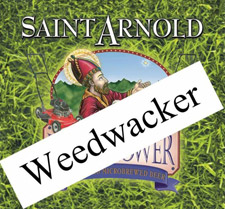“Brewers make wort, yeast makes beer.”
– A veteran brewer or a clever yeast salesman
Saint Arnold Brewing in Texas just announced a “Moveable Yeast” series of beers, quarterly releases with the first in August.
From the press release: “The concept behind the Movable Yeast series is to focus on the flavor contribution of yeast. Each release will be created by brewing a regular batch of a Saint Arnold beer and then splitting the wort into two 60-barrel fermenters. One fermenter will be pitched with the yeast normally used in that beer and the second fermenter will be pitched with an alternative yeast and the beer given a different name.”
 For the first release Saint Arnold’s brewers will create the base wort for the best-selling Fancy Lawnmower Beer, a 4.7 percent beer made with mostly pilsner malt and a little bit of malted wheat, light and thirst quenching in gawdawfulhot Houston. They’ll ferment half as they always do and half with a hefeweizen yeast sourced from Bavaria. That strain typically adds banana and clove character to a beer (see geeky details).
For the first release Saint Arnold’s brewers will create the base wort for the best-selling Fancy Lawnmower Beer, a 4.7 percent beer made with mostly pilsner malt and a little bit of malted wheat, light and thirst quenching in gawdawfulhot Houston. They’ll ferment half as they always do and half with a hefeweizen yeast sourced from Bavaria. That strain typically adds banana and clove character to a beer (see geeky details).
This beer will be called Weedwacker and won’t be filtered.
“People spend a lot of time talking about the malt and hops used in beers, but yeast is discussed little and probably understood even less. We thought this would be fun, tasty and educational,” Saint Arnold founder Brock Wagner said for the press release. “We’re hoping that bars and restaurants will offer both beers at the same time so that people can compare the flavor differences.”
The beers are scheduled to go on tap Aug. 16 in select restaurants and bars. A 60-barrel batch will yield about 20,000 12-ounces servings so don’t expect the beers to be around long.
Saint Arnold Weedwacker will be followed in mid-November by Saint Arnold Altared Amber, Amber Ale wort pitched with a yeast sourced from a Belgian Trappist brewery. In mid-February 2011, the brewery plans to release Saint Arnold Bitter Belgian, Saint Arnold Elissa IPA wort also pitched with a Trappist yeast. In mid-May 2011, Saint Arnold Brown Bitte is due, which will be Saint Arnold Brown Ale wort pitched with an altbier yeast.
Now, the geeky details
Feel free to stop reading now. Different yeast strains create different esters and phenols during fermentation that we perceive as flavor and aroma. Strains used by Bavarian brewers to make weizen beers and by some Belgian brewers (including those in Trappist monasteries) share certain characteristics.
Two key players are an ester called isoamyl acetate and a phenol known as 4-vinyl guaiacol. The former is responsible for banana and other fruit flavors and aromas, the latter for the clove character you expect in a hefeweizen or the spiciness in a Belgian tripel (or clove, which is not such a good thing in a tripel).
Although brewers long ago mastered delivering the clovelike aroma and flavors that help define German weizen beers, and to a lesser extent Belgian whites, not until the 1970s did they discover that weizen and other “Phenolic Off-Flavor” (POF+) yeasts convert ferulic acid to 4-vinyl guaiacol. These include weizen and wit yeasts in varying degrees, but also yeast used to ferment Belgian strong ales and even English ales.
A key, however, is shaking ferulic acid free of malted wheat, barley or oats. Different experiments have yielded various results but a rest (sensibly enough called a “ferulic acid rest”) during the mashing process somewhere in the range between 104 and 113° F seems to yield the best results. A longer rest, more clove. I’d be surprised if that rest was part of production at Saint Arnold. I’d sure like to be in Houston in August to taste the results.
My presentation at the recent National Homebrewers Conference included a little compare and contrast between weizen yeast strains and Belgian strong ale strains (such as those Saint Arnold will use in future beers in this series). Kristen England brewed four batches with varying combinations of grains, mashed them in different ways and fermented them with different yeast strains. Attendees rated them (it was a “blind” tasting) on how much wheat character they exhibited, overall fruit, banana, and clove/spice. When I have time to make sense of the results I’ll post that with the presentation at Brewing With Wheat.
And if you want to get really serious about yeast then start saving your pennies to buy “Yeast: The Practical Guide to Beer Fermentation” from Brewers Publications. It should be available in September. As I’ve mentioned before it is the first in a series of books about beer’s major ingredients. I’m writing the hops book.